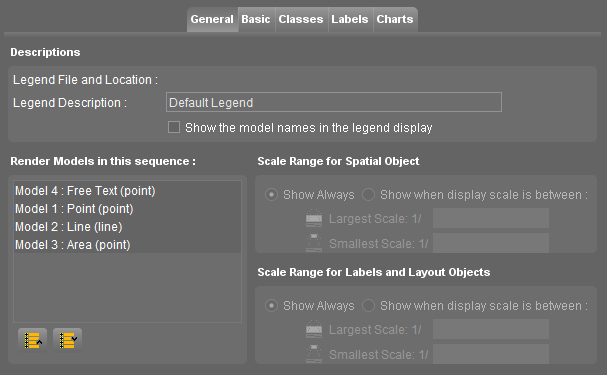For documentation on the current version, please check Knowledge Base.
Dataset Legend : General Settings
This page describes all functions of the Orbit desktop Legend Editor “General” tab :
- Legend file description.
- Sequence of model rendering if the dataset contains multiple models (Vector Data Structure).
- Scale range limitations for each model individually.
![]() Dataset List > Dataset Context Menu > Legend Editor > General
Dataset List > Dataset Context Menu > Legend Editor > General
Dataset List > Dataset Context Menu > Dataset Properties > Legend Editor General

Descriptions
Legend File and Location : Storage location of the dataset Orbit Legend File (*.olg).
Legend Description : Optional description, useful when having multiple legend files for one dataset. This description can be added to the Legend Display via the checkbox below.
Render Models in this sequence
It is possible to set the order of rending models within one dataset. Overlying models will cover underlying models. It is advised to respect the model spatial type, from top to bottom : points, lines, areas and image models.
Select the model and use the appropriated Up and Down buttons at the bottom.
Scale Ranges for Models
Restrict the display of spatial (objects) and layout (labels, pie charts) component of each dataset model on Map 2D to a well defined scale range. Outside scale ranges the components won't be displayed.
To set a single scale range limit for the entire dataset and for more information about scale range limits, see Dataset Properties Inspect.
Remarks on dataset legend scale range limits :
- Scale ranges on dedicated dataset components can be useful to simplify the map presentation to improvie the overal readability.
- Contrary to dataset scale range limitation, the dataset user name won't be displayed italic when dataset legend scale range limits are applied, see Dataset Operations and Indicators in DataSet List.